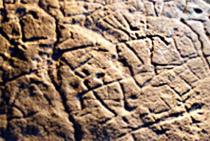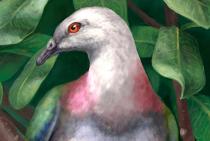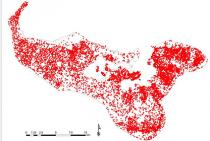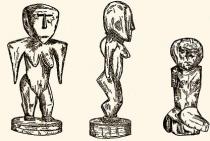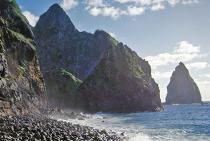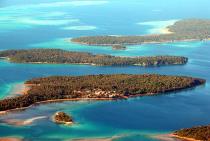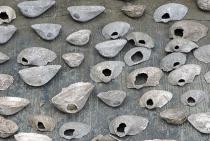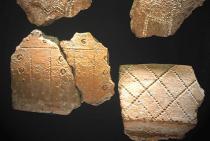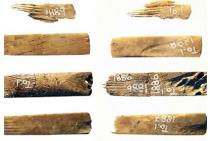In the field of ancient DNA remarkable new insights for Oceanic settlement are being revealed. The Lapita migration across Oceania was rapid, and undertaken by a homogeneous group both culturally and genetically. Arriving in Tonga almost three millennia ago, it marks the birth of Polynesia. By David V. Burley and Geoffrey R. Clark.
You are here
Results for Archaeology
Friday 29 January 2021
Nuku'alofa, Tonga
Saturday 15 August 2020
Nuku'alofa, Tonga
The beach and lagoon at Houmale‘eia on the north end of Foa Island in Ha‘apai is a spectacular place. Now home to Matafonua Lodge, its ancient history came vividly to life in 2008 when Australian visitors inadvertently discovered a kaleidoscope of images carved into a beach rock surface. Human feet, triangular bodied people, lizards, dogs, turtles and other representations hinted astoundingly at a Hawaiian connection. By Shane Egan and David Burley.
Friday 24 July 2020
Gainesville-Florida, USA
A large fruit-eating bird from Tonga joins the dodo in the line-up of giant island pigeons hunted to extinction. New research into fossils shows that ‘Tongoenas burleyi’, a newly described genus and species, inhabited the Pacific islands for at least 60,000 years, but vanished within a century or two of human arrival around 2,850 years ago. The size of a large duck, ‘T. burleyi’ was likely capable of swallowing fruit as big as a tennis ball, said study lead author David Steadman.
Saturday 27 June 2020
Nuku'alofa, Tonga
Burial mounds are widely scattered across the Tongatapu landscape. When you land at Fua’amotu airport, they line the runway. When you drive into Nuku’alofa, they can be seen to either side of the road. All but a few are without name, and the individuals buried within are long lost to history. Yet these mounds represent a story that literally is inscribed on the landscape. Using airborne LiDAR data, a computer application was developed to count the mounds. The total was astounding, including upwards of 10,000 of these sites on Tongatapu - about 40 mounds for every square kilometre. By Travis Freeland and David V. Burley.
Saturday 16 May 2020
Nuku'alofa, Tonga
On November 2, 1866, the Reverend Shirley Waldemar Baker, missionary and eventual Prime Minister of Tonga, gave a lecture in which he describes the last traditional God House in Ha'apai....“I have stood in the old Fale Mee at Haano, which is the last fale otua (temple of their god) still standing in Haapai. At the foot of the principal post there is buried a man, who was said to be the best singer in all Tonga. He was offered a living sacrifice to the god at the building of the temple, as an act of dedication.” By David V. Burley.
Thursday 16 April 2020
2 comments
Nuku'alofa, Tonga
‘Ata, Tonga’s southernmost island, is a long way away, separated from Tongatapu by 160 km of open ocean. ‘Ata’s place in the history books is well established. It was here, in June 1863, that the whaling ship Grecian under Captain Thomas McGrath anchored off the northeastern shore and only village, Kolomaile. The details of the events that followed are sketchily recorded, but the consequence is notorious. A large number of ‘Ata’s residents were lured on to the ship, captured, and then sold to a Peruvian slaver for transport to Lima. None were to return. In the aftermath of the raid, and under the orders of Tupou I, the remaining ‘Atans were resettled on ‘Eua, in a village they again named Kolomaile. By David V. Burley.
Thursday 19 March 2020
Nuku'alofa, Tonga
Tonga's stunning ngatu provide testimony to the considerable antiquity of Tongan artistic designs. Variation of the ngatu patterns, and the way these are organized, had been inscribed on the surfaces of Lapita pottery in Tonga almost 3,000 years ago. By David V. Burley.
Friday 7 February 2020
Nuku'alofa, Tonga
People first arrived in Vava‘u between 850 and 810 BC, establishing themselves on the south central islands offshore of ‘Uta Vava’u. The earliest sites at Ofu, Pangaimotu and Otea are all but identical in their age, and they are coincidental with the oldest sites in Ha’apai. Bird remains aside, excavations of other types of food remains at these sites have an unexpected story to tell: one of scarcity. Fish remains were shockingly limited! Shellfish counts and species diversity are similarly impoverished, illustrating limited productivity, or at least limited sustainability, for reef foraging efforts. By David V. Burley.
Wednesday 15 January 2020
Nuku'alofa, Tonga
We can confidently position first settlement in Ha’apai between 825 and 810 BC, only three generations (75 years) after the first Lapita canoes arrived at Fanga ‘Uta Lagoon on Tongatapu. The dates for individual Lapita sites are informative. They not only answer the question of when, but they reflect upon the process by which the expansion was undertaken. Within Ha‘apai, simultaneous settlement, widely dispersed hamlets on different islands, and small groups of people clearly speak to a planned and organized strategy. In its creation of a settlement network northward from Tongatapu, it brilliantly laid title to these islands. By David Burley.
Thursday 2 January 2020
Nuku'alofa, Tonga
There are rare moments on an archaeological project which offer extraordinary insight into the past or when the past connects with the present in an utterly astonishing way. Both occurred in late July of 2007, as we were carrying out archaeological excavations in the village of Nukuleka at the northeast entrance to Fanga ‘Uta Lagoon on Tongatapu. This story is about the documentation of a shell game, taupita, but a shell game, as we found out, with an almost 3000-year-old history. It also is a story that binds Tonga’s earliest Lapita ancestors to the people of Nukuleka today. By David Burley and Sean Connaughton.
Monday 16 December 2019
Nuku'alofa, Tonga
Tongatapu was a far different place 3000 years ago, one few of us can imagine today. The sea was higher, almost 1.4 m higher. Much of the land on which the city of Nuku‘alofa now sits was not land at all. It was about 900 BC when voyaging canoes first arrived from a homeland to the west. These kalia carried a small group of people and all of the necessities they would need to settle new found islands. They were the first Tongans. By David Burley
Tuesday 5 March 2019
Brisbane, Australia
A recent study of four ancient bone tattoo comb tools, found in Tonga in 1963-64, has revealed they are the oldest confirmed in the world, and surprisingly two are made from human bone, say researchers in Australia. Radiocarbon dating determined the tools to be 2,700 years old



